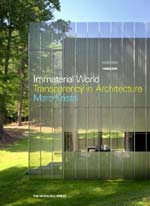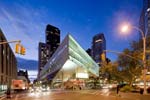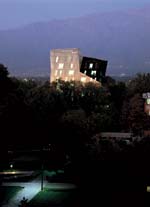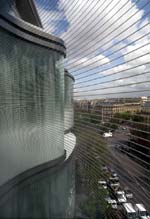
|

|
|
Home Site Search Contact Us Subscribe
|
|
|
Book Review: "Immaterial World: Transparency in Architecture": Marc Kristal crystallizes increasingly complex notions of transparency with a light touch. Although most of the 25 projects discussed are well-known, they take on additional meaning in this sensitively curated selection. By Norman Weinstein March 25, 2011 “Transparency” can act as a shockingly opaque word, and its use in architectural discourse has been regrettably muddy. While the folk adage of people living in glass houses needing to curb their stone throws lives on, Philip Johnson’s glass house transitions into a crowded tourist Mecca, leaving Johnson’s original commitment to a lucidly stark interpenetration of house and landscape behind. As Helmut Jahn, pioneering 20th-century architect of innovative transparency, and a muse to the 21st-century designers in this book, wrote in the 1990s: “Transparency is not the same as looking straight through a building: it’s not just a physical idea, it’s also an intellectual one.”
With Immaterial World: Transparency in Architecture (The Monacelli Press, $45), Marc Kristal has created just the right kind of introductory overview to recent trends in architectural transparency. Eschewing academic theories, Kristal’s presentation – 200 color illustrations of 25 projects matched with 200 pages of illuminating text – touches on both the intellectual and physical implications of designing with transparency in mind.
Although most of Kristal’s examples are well-known, they take on additional meaning in this sensitively curated selection. The Alice Tully Hall redesign by Diller Scofidio + Renfro, with FXFOWLE Architects, is masterfully framed as a design lending transparency and lightness to all of Lincoln Center, suggesting building transparency as a gift that extends to the larger urban fabric.
Less publicized but equally stunning, Alejandro Aravena’s “Siamese Twins” Chilean laboratory thickens conventional notions of transparent design through encasing a fiber-cement structure suggesting Siamese twins within a floating glass skin. Aravena’s rhythmic interplay of glass and fiber-cement, public and private spaces, for his campus laboratory finds parallels in a number of other designs. Toyo Ito’s Tod’s Omotesando, a flagship luxury-brand store in a swanky section of Toyko, showcases transparent openings unpredictably punctuating an opaque volume. At night the store glows like a larger-than-life, ribbon-festooned, gift package with a luminous present hidden deep within.
What emerges from these projects that encompass a range from modest private homes to skyscrapers is a deep appreciation of transparency (in all of its myriad forms) becoming as versatile a feature in 21st-century architecture as the basic black dress in a fashionable wardrobe. Christian de Portzamparc’s Renaissance Paris Arc de Triomphe Hotel shimmeringly adds a shock of the new to the otherwise staid Avenue de Wagram through a façade suggesting six floors of undulating glass ribbons. Although Portzamparc was aware of zoning requiring all buildings within 500 meters of the Arc de Triomphe to be built from stone, he astonishingly finds the bureaucrat who lets his design materialize, this official bonhomme who proclaims, “This is against the rules but it’s beautiful, and it is not my duty to be against creation.”
Eminently browsable, Kristol’s book invites additional research, reflection, and archi-tourism. The photography is first-rate, the writing sharply entertaining and informative. Only the title might be improved. How about Architecture through the Looking Glass: Architectural Adventures in Transparency?
Norman Weinstein writes about architecture and design for Architectural Record, and is the author of “Words That Build” – an exclusive 21-part series published by ArchNewsNow.com – that focuses on the overlooked foundations of architecture: oral and written communication. He consults with architects and engineers interested in communicating more profitably; his webinars are available from ExecSense. He can be reached at nweinstein@q.com.
More by Weinstein:
A Meditation on the Beauty of Zaha Hadid's Door Handle Hadid's design issues a challenge: define beauty by lyrically playing with illusion.
Why "Greatest
Hits" Lists by Architecture's Stars Should Be Mocked
Celebratory Meditations on SANAA Winning the Pritzker Prize
Op-Ed: Life After Ada: Reassessing the Utility of
Architectural Criticism
Book Review:
"Visual Planning and the Picuresque" by Nikolaus Pevsner. Edited by
Mathew Aitchison
Book Review: How New
Urbanism's Case Triumphs Best Through "The Language of Towns & Cities:
A Visual Dictionary" by Dhiru A. Thadani
Best Architecture
Books of 2010
Book
Review: "Architecture and Beauty: Conversations with Architects about a
Troubled Relationship": Yael Reisner exuberantly interviews architects about
beauty
Book Review: Shedding
Light on Concrete: Tadao Ando: Complete Works 1975-2010 by Philip Jodidio
Book Review: Sage
Architectural Reflections from Architecture's "Athena": Denise Scott
Brown's "Having Words" distills a lifetime of theorizing and practice
into practical and succinct guidance for thriving through difficult times
Book Review: Keeping
the Architectural Profession Professional: "Architecture from the Outside
In: Selected Essays by Robert Gutman" celebrates Gutman's legacy as
invaluable outsider
Book Review: "Design
through Dialogue: A Guide for Clients and Architects," by Karen A. Franck
and Teresa von Sommaruga Howard
Twilight Visions: Vintage Surrealist Photography Sheds
New Light on Architecture
Best
Architecture Books of 2009
Book Review: "Gunnar Birkerts: Metaphoric Modernist" by Sven Birkerts and Martin Schwartz A major architect in the history of Modernism finally receives recognition – and sundry asides about why Modernism never exited.
Book Review:
"Urban Design for an Urban Century: Placemaking for People," by Lance
Jay Brown, David Dixon, and Oliver Gillham
Book Review:
"Everything Must Move: 15 Years at Rice School of Architecture
1994-2009"
Book Review: A Subversive Book Every Architect Needs:
"Architect's Essentials of Negotiation" by Ava J. Abramowitz
Book Review: A Perspective from One Elevation: "Conversations With Frank Gehry" by Barbara Isenberg Gehry's conversations offer portraits of an astute listener as well as talker, an architect as aware of his flaws and limitations as of his virtues.
Best Architecture Books of 2008
Book Review: You've Got to Draw the Line Somewhere A review of Drafting Culture: a Social History of Architectural Graphic Standards by George Barnett Johnston
Book Review: "NeoHooDoo: Art for a Forgotten Faith," edited by Franklin Sirmans Sharpen your pencils - and get ready to do a NeoHooDoo shimmy.
|
(click on pictures to enlarge) 
 Iwan Baan Diller Scofidio + Renfro with FXFOWLE Architects: Alice Tully Hall, New York, New York  Cristobal Palma Alejandro Aravena: Siamese Towers, Santiago, Chile  Matthias Reithmeier, Diamond Graphics/Seele Atelier Christian de Portzamparc: Renaissance Paris Arc de Triomphe Hotel, Paris, France |
© 2011 ArchNewsNow.com